heracl.es · @heracles
169 followers · 1606 posts · Server mastodon.socialReiterating my hopeless dream for someone to hack around #LiteXL so that it works and feels like #NotationalVelocity. I can’t get over how small its “keyboard-to-photon ratio” is.
Digital Mark λ 🕹 💾 🥃 · @mdhughes
1100 followers · 24552 posts · Server appdot.netOK, that was kinda fun but silly.
https://lite-xl.com/en/
I had to grep source to figure out how to set tabs to 8 where I like them, and then only shows up on relaunch. Editing literal lua source is even dumber than Sublime's JSON files, which are at least documented.
Of course it can't highlight Scheme or LISP or nothin'. Very millennial hipster languages based.
Not a lot of themes. dark puke here was the least bad.
The whale · @thewhalecc
285 followers · 1739 posts · Server framapiaf.orgwalkero · @walkero
26 followers · 96 posts · Server mastodon.socialWhile I was experimenting today with the latest release of @haiku r1beta4, which was released earlier today, I managed to port #LiteXL to it. It is still really premature but seems to work quite well.
I plan to keep on working on this and create a proper release. There is a lot I need to learn about Haiku, but I am really happy I will have my beloved editor to work with.
heracl.es · @heracles
72 followers · 1499 posts · Server mastodon.socialNot to mention… #LiteXl is Open Source, community developed: http://lite-xl.com
Some more promising, native first approaches: http://lapce.dev (FOSS) and the superteam led http://zed.dev (likely commercial).
heracl.es · @heracles
72 followers · 1498 posts · Server mastodon.social#LiteXL is remarkable: 6MB on disk; less than 100MB RAM; simple but capable plugins; color schemes; multiple panes; tidy, customizable interface; responsive from cold-start in a couple of secs. Sure, needs work around wrapping, unicode substitution, plugin ecosystem.
Boiling Steam · @boilingsteam
2992 followers · 7723 posts · Server mastodon.cloudTired of Vim/Emacs? Here's Lite XL, a lightweight text editor written in Lua: https://github.com/lite-xl/lite-xl #foss #lua #litexl #texteditor #linux
#foss #lua #litexl #texteditor #linux


